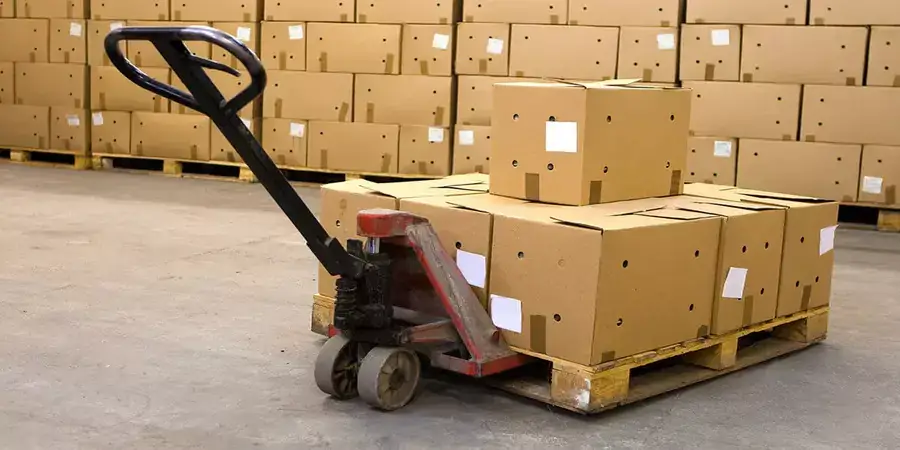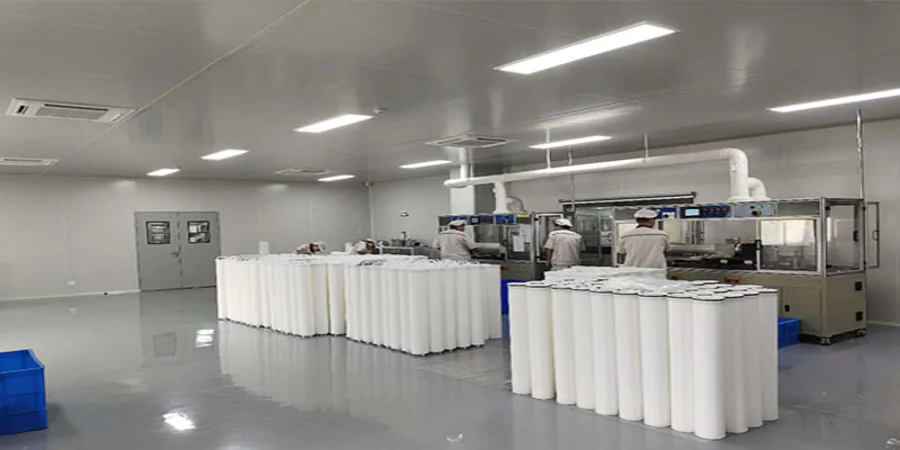Tough logistics operations need pallets that can handle serious weight without problems. Looking at this, we can see size matters – but it’s not the whole story. Square pallets and metal ones are ideal for moving heavy items in global supply chains. Their robust construction helps keep operations safe and running smoothly.
Due to their stable design, pallets do not fail after the first use and are often reused. For example, wooden pallets that lose no more than 15% of their strength when new. They also cost more than three times less than new ones, according to RePackify.
Optimal Pallet Dimensions for Maximum Weight Capacity
Pallet size affects how much weight it can hold. Some designs work better for heavy loads. Size alone won’t ensure higher capacity, but certain dimensions are more effective.
Square Pallets (48” x 48”)
Square pallets provide great stability and weight distribution. Their balanced design makes them ideal for heavy use. The 48” x 48” format stands out in performance metrics:
Wood versions can safely hold about 4,673 lbs. This is true if they are built well with strong stringers and deck boards.
High-quality plastic versions can support static loads of 20,000 lbs. They also handle dynamic loads between 2,500 and 4,000 lbs.
These setups fit four 55-gallon drums perfectly, with no overhang. They are great for transporting chemicals, petroleum, and hazardous materials.
The square design resists tipping. This gives better stability for tall or unstable loads.
For industries that need stability, the 48” x 48” format offers a balanced base. It spreads weight evenly in all directions. This is especially important for liquid containers, machine parts, and building materials. Load shifting in these areas can lead to dangerous situations.
Specialized Rectangular Dimensions
The 48” x 36” setup can safely hold a maximum load of 5,261 lbs. This shows that smart design can beat just being bigger.
The standard North American GMA pallet measures 48” x 40”. It can hold between 4,592 and 4,600 lbs if built correctly.
Well-made rectangular pallets can sometimes work better than larger ones. This happens when they use smart reinforcement and load distribution methods.
Asian and European Heavy-Load Standards
Global trading partners created standard dimensions for their transportation systems:
In Asia, the square 1100mm x 1100mm (43.30” × 43.30”) pallet is widely used for heavy-duty applications.
The European 1200mm x 1000mm (47.2” × 39.4”) pallet is now popular for shipping heavy goods. It works well with both European and American logistics systems.
The Euro EPAL 2 Pallet (1200 x 1000 x 162 mm) supports static loads of up to 4,500 kg (9,920 lbs). It also has a dynamic capacity of 1,500 kg (3,307 lbs).
Material Selection for Maximum Load Capacity
The material in pallet construction affects weight capacity more than size does. Each material offers distinct advantages for heavy-load applications.
Metal Pallets: Ultimate Strength-to-Weight Ratio
Metal pallets consistently demonstrate the highest weight capacity regardless of size:
Aluminum pallets can support static loads of 30,000 lbs. They also manage dynamic loads of 5,000 lbs. This makes them perfect for heavy industrial use.
Metal pallets are fireproof. This makes them safe to use where fire safety rules ban wood or plastic options.
Metal pallets may cost more upfront, but they often save money in the long run. They last longer and resist damage, making them ideal for heavy applications.
Engineered Plastic Pallets: Balancing Strength and Weight
Advanced plastic pallets offer impressive weight capacities while maintaining lighter handling weights:
High-performance 48” x 48” plastic pallets support static loads of 20,000 lbs. That’s similar to some metal pallets. Plus, they weigh less than 51 lbs.
The SQ4848-RRB plastic pallet has great capacities: static (20,000 lbs), dynamic (4,000 lbs), and racking (2,200 lbs). It features a six-runner cruciform bottom base design.
Recycled HDPE with mineral additives makes plastic pallets. These pallets are five times stronger than wooden ones. They resist insects, mold, chemicals, and moisture.
Heavy-duty plastic pallets have a closed deck design. This design prevents small items from falling through. It also gives great support for slip sheets and uneven loads.
Engineered plastic pallets are ideal for tasks that require regular cleaning. They can also handle moisture, chemicals, and biological contaminants. They offer great strength and practical benefits.
Wood Pallets: Economic Strength Through Design
Traditional wood pallets usually have lower capacities than plastic or metal ones. However, some special wooden designs can deliver impressive results.
Heavy-duty wooden pallets, measuring 48” x 48”, can usually hold 3,000-3,500 lbs. They also offer good cost benefits.
Critical Design Elements Beyond Size and Material
The design inside a pallet usually sets its weight limit. This is true no matter the size or main material.
Structural Components That Enhance Capacity
The configuration of support elements significantly influences maximum load capacity:
Reinforced corners and edge designs boost racking performance. This is key for storing heavy goods in warehouses.
Block-style pallets are better than stringer designs for heavy loads. They spread weight across more support points.
Load Type Differentiation
Pallet specifications define different capacity measurements based on the load type.
Static load capacity means the weight supported while resting on a flat surface. It is the highest capacity measurement and is usually 4 to 6 times higher than dynamic ratings.
Dynamic load capacity, or the weight it can lift or move, usually ranges from 1,500 to 5,000 lbs for heavy-duty designs.
Racking load occurs when support is only at the edges in warehouse racking systems. This situation is tough. Capacities are usually only 30-50% of dynamic ratings.
Knowing these differences is key for choosing the right pallet. An application’s handling needs might focus on one type of capacity more than the others.
International Standards and Regional Preferences
Different regions around the world use standard pallet sizes. These sizes are designed for specific uses, transport systems, and handling equipment.
ISO-Approved Dimensions
ISO has approved six pallet sizes for global trade:
Rectangular formats: 1200 × 800 mm (47.2” × 31.5”), 1200 × 1000 mm (47.2” × 39.4”), and 1219 × 1016 mm (48” × 40”)
Square formats: 1067 × 1067 mm (42” × 42”), 1100 × 1100 mm (43.3” × 43.3”), and 1140 × 1140 mm (44.9” × 44.9”)
Standardized dimensions help global trade. They ensure compatibility with international transport systems and handling equipment.
European Heavy-Duty Standards
The European Pallet Association (EPAL) has developed specific standards for heavy-load applications:
The standard Euro pallet measures 1200x800x144 mm. It has a dynamic capacity of 1,500 kg (3,307 lbs) and a static capacity of 4,000 kg (8,818 lbs).
Euro EPAL 2 (1200x1000x162mm) and EPAL 3 (1000x1200x144mm) pallets can hold up to 4,500 kg (9,920 lbs) when static.
EPAL certification ensures consistent quality and performance standards across all certified pallets.
Industry-Specific Applications for Heavy-Load Pallets
Different industries have developed specialized pallet configurations to address their unique heavy-load requirements.
Chemical and Hazardous Materials
The chemical industry depends on specialized pallet designs. These designs balance weight capacity with extra safety features.
The 48” x 48” square format works well for transporting drums. It lets you fit four 55-gallon drums without any overhang.
Closed-deck plastic designs stop spills from collecting in low spots. They also resist chemical damage.
Metal pallets enhance safety for flammable materials. They do this by removing the fire risks found in wooden pallets.
Agricultural and Food Production
Food and agriculture face special challenges. They deal with heavy loads and must follow sanitation rules.
Heavy-duty plastic pallets have closed decks. They stop contamination. They also hold heavy items like canned goods, liquids, and bulk ingredients.
Plastic and metal pallets don’t absorb moisture. This stops bacteria from growing and keeps them clean.
Food-grade plastic pallets are strong and easy to clean, meeting regulations.
Best Practices for Heavy-Load Pallet Selection
When choosing pallets for heavy loads, keep these best practices in mind:
Focus on application needs: Check if the app needs static, dynamic, or racking capacity. These values can differ a lot.
Think about total ownership cost. Metal and engineered plastic pallets cost more upfront than wood. However, they last longer and break less often. This usually leads to lower costs per use for heavy applications.
Evaluate handling needs: Four-way entry designs make access easier in tight spaces. Two-way designs can provide better strength for heavier loads.
Align pallet specs with storage needs. Warehouse racks need pallets that can hold more weight on the edges. This is more than those used just for ground storage or transport.
















